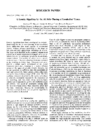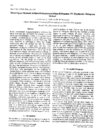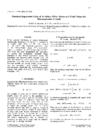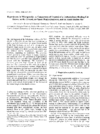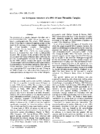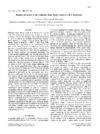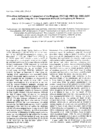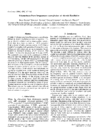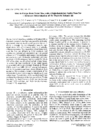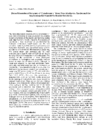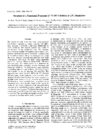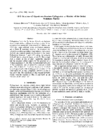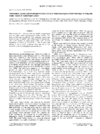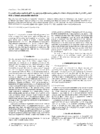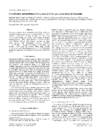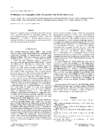issue contents
March 1996 issue

Cover illustration: NMR solution structure of an Antennapedia homeodomain complex with a 14-base pair operator DNA duplex. The dotted surface outlines a hydrated cavity in the protein-DNA interface.
research papers
Efficient survey methods have been developed for ab initio phasing of low-resolution X-ray diffraction data from highly symmetric structures such as viruses. A direct-space parameterization incorporating structural symmetry is linked to a genetic algorithm, and novel selection criteria are used focusing on detecting possible Babinet crossovers.
In the double-histogram method electron density is modified to give a target histogram which depends on either the maximum for the variance of local density contained in a spherical volume around each point. This is shown to be far more effective than the conventional histogram-matching method.
The statistical evaluation of the Debye-Waller factor for a unit-cell distribution of atomic B values is used to improve intensity modfication for protein crystals.
Crystals of the Fab from antibody YsT9.1 were grown aboard space shuttle Discovery, space station Mir and on the ground. A small but significant improvement in crystal quality was observed in the crystals that were grown in microgravity over the corresponding ground-based experiments.
In the structure of a DNA 15-mer thrombin complex two different binding orientations for the 15-mer fit the X-ray diffraction data equally well.
We have grown crystals containing twofold symmetric nucleosome core particles prepared using an improved purification technique. X-ray data collected using a rotating-anode source demonstrates that diffraction is isotropic to 3.2 Å; with observed reflections extending to d spacings of 2.8 Å.
The structure of chitinase from barley seeds has been determined by molecular replacement and refined at 2.0 Å resolution.
PDB reference: 1cns
A comparative X-ray refinement study on a drug-DNA complex utilizing a single 1.4 Å data set collected at 120 K. Four refinement programs are used and comparisons are made between different srategies of refinement and the resulting models obtained.
PDB reference: 224d
The crystal structure of the complex of the antibody Fab, HyHEL-5, with its antigen, hen egg-white lysozyme, has been refined to an R value of 0.196. The resulting model has improved phases compared to the previously reported model, PDB reference 2HFL, permitting the reliable location of a number of water molecules and a better definition of the antibody-antigen interface.
PDB reference: 3hfl
Two structures of RNase Sa at 1.2 Å resolution were refined with isotropic and anisotropic temperature factors. A comparison of different refinement procedures was made.
To remove the bias introduced by the molecular replacement model, an automated refinement procedure [Lamzin & Wilson (1992). Acta Cryst. D49, 129-147] was successfully applied in solving the PcpA subunit III structure. This procedure provided a dramatic improvement of the map which led to extensive rebuilding of the model.
The crystal structures of cytochrome c' from two Alcaligenes species have been determined at high resolution. The structures are analysed in terms of conservation in the cytochrme c' family and the principles of four-helix bundle proteins.
The crystal srtructure of the functional fragment of VCAM-1 has been refined to 1.9 Å. The feature of integrin-binding site is discussed.
PDB reference: 1vsc
X-ray structure of a serine collagenase. The two molecules of the asymmetric unit mimic protein/inhibitor interactions.
PDB reference: 1hyl
The three-dimensional structure of the catalytic domain of xylanase A from Pseudomonas fluorescens has been refined at 1.8 Å resolution (R factor of 0.166). Three β-bulge type distortions serve to orient important active-site residues.
PDB reference: 1clx
short communications
Crystals of Aspergillus niger pectin lyase have been grown and are suitable for structure determination. Data have been collected and processed to better than 2 Å resolution.
Crystals of aldehyde reductase from Sporobolomyces salmonicolor have been grown from ammonium sulfate solution by vapor diffusion. The hexagonal crystals are in space group P6122 or P6522 and have unit-cell dimensions a = 72.2 and c = 320 Å.
A medium-sized haemorrhagin, AaHIV, from the snake venom of Agkistrodon acutus has been purified and crystallized. Its molecular weight is 44 kDa and its crystal belongs to space group C2221
β-crustacyanin crystallizes in space group P622 with crystals diffracting beyond 3.0 Å.
Two new crystal forms of calmodulin, one triclinic and one orthorhombic (P212121) are described.
A protein extracted from the seeds of Pachyrrhizus erosus crystallized in tetrgonal system with cell parameters a = b = 62.52, c = 147.42 Å, and a data set at 3.1 Å resolution has been collected.
The primary receptor (pot D, Mr 39 000) of the polyamine transport system in Escherichia coli has been crystallized. Two crystal forms grown in the presence of spermidine are promising for structural determination at atomic resolution.
Two non-native forms of bovine porphobilinogen synthase have been crystallized in the I422 space group. The crystals diffract to 3.6-3.9 Å and the unit cell contains two octameric units.
international union of crystallography
Free 



 journal menu
journal menu









